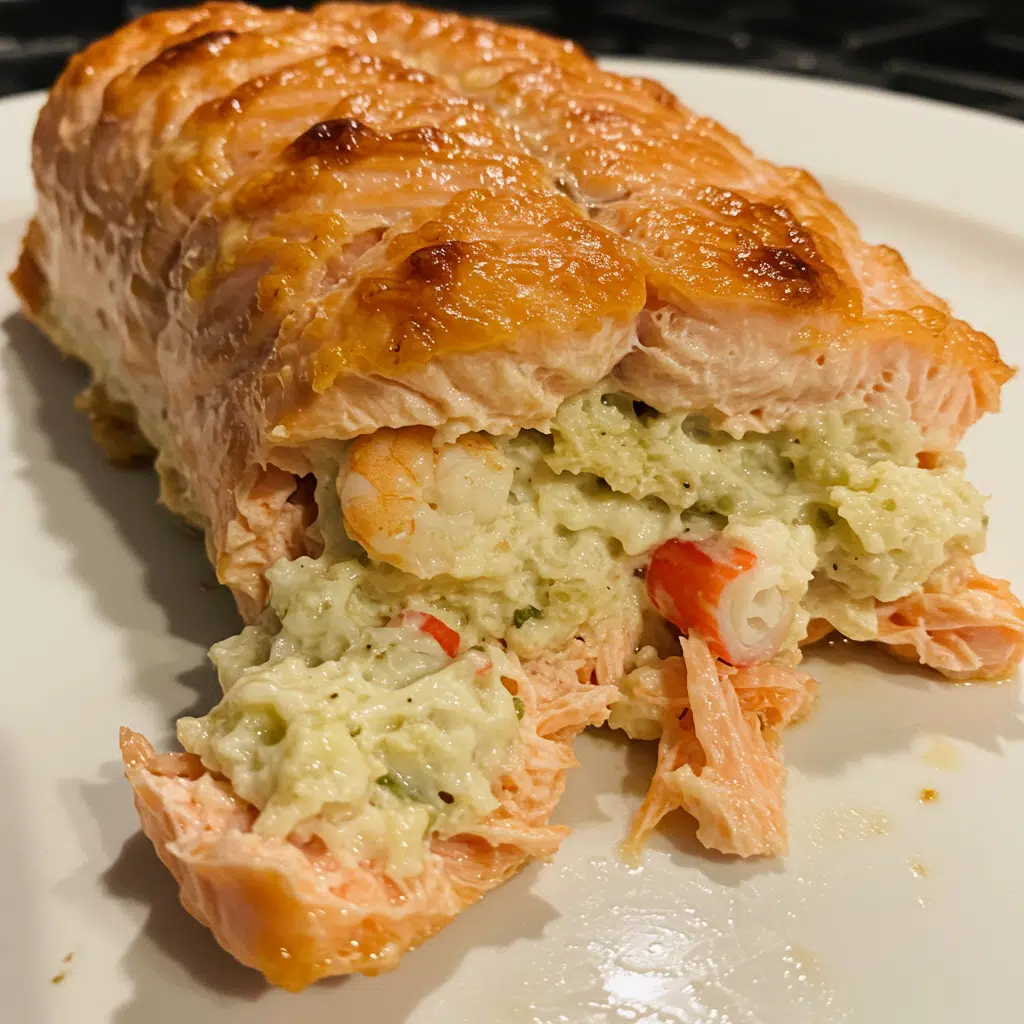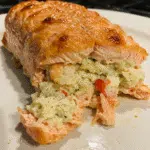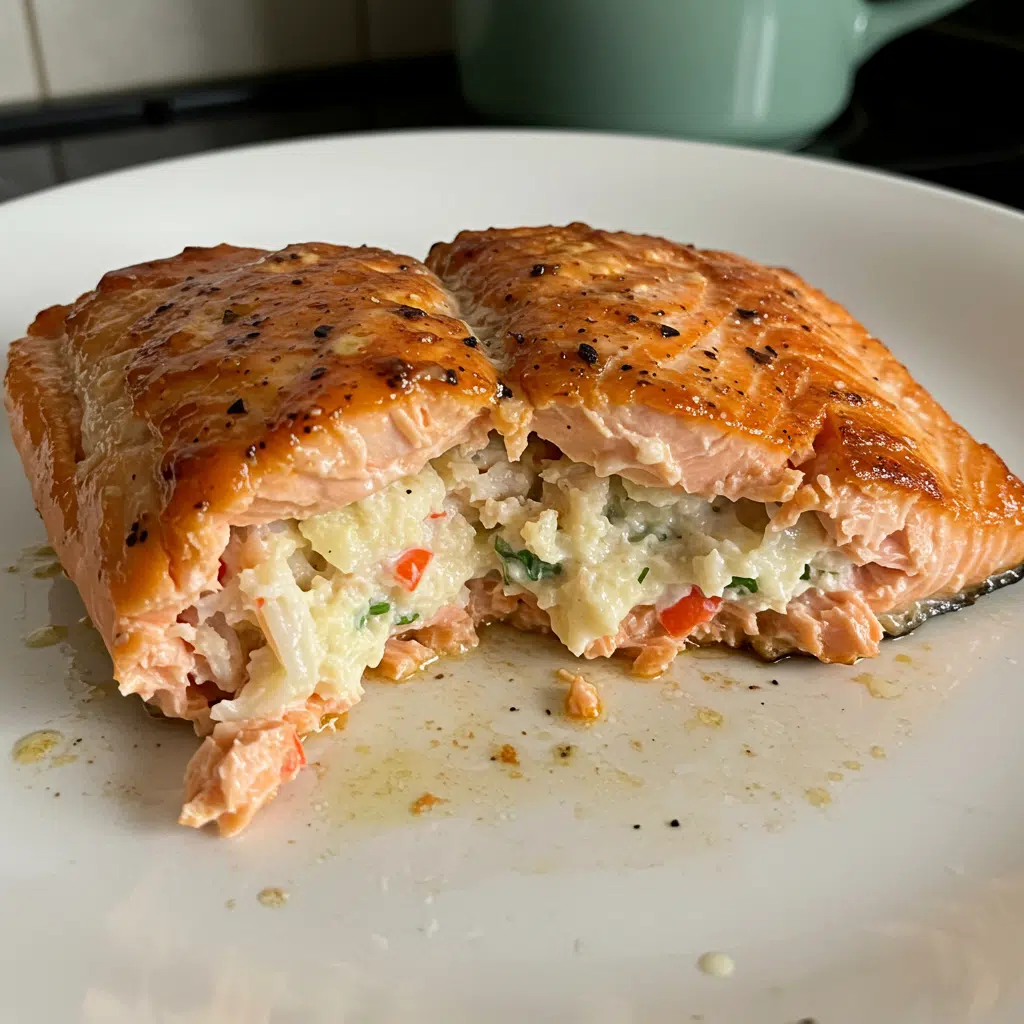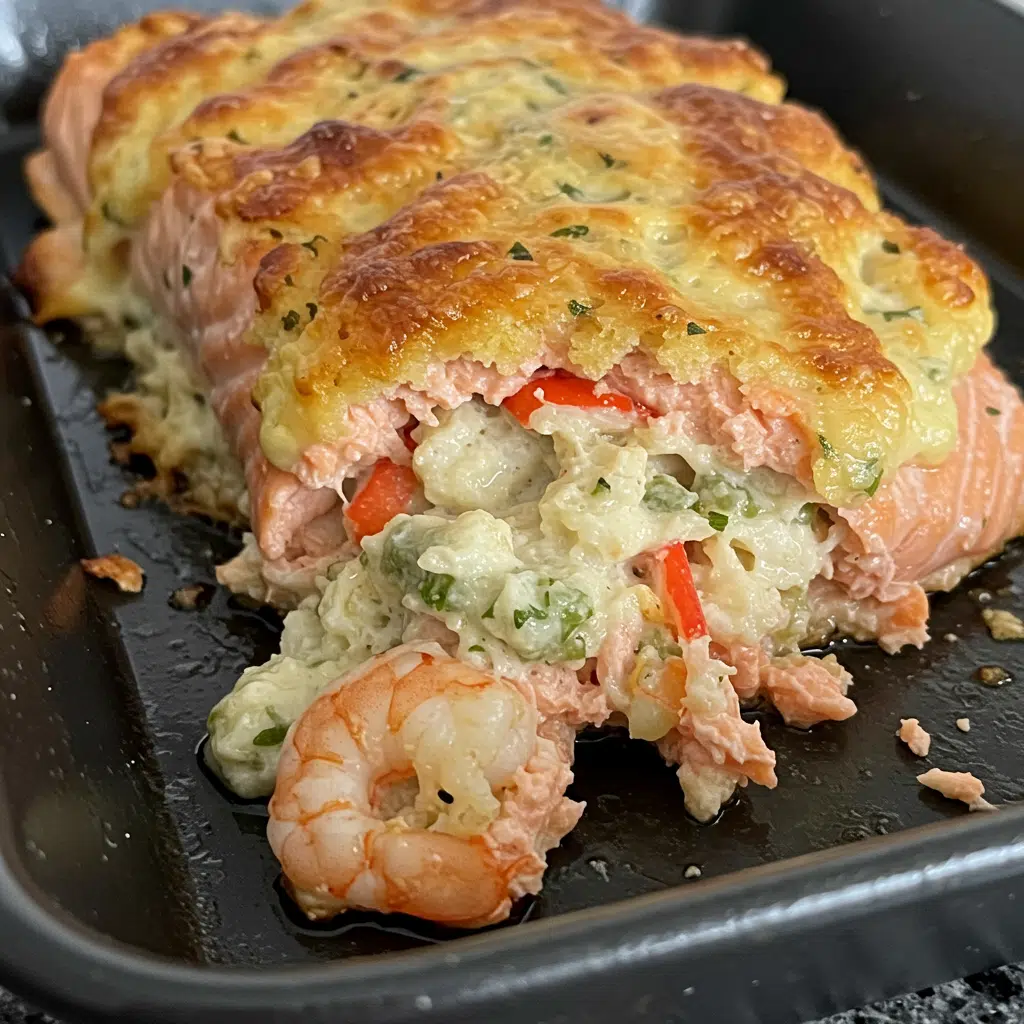Crab Shrimp Stuffed Salmon is tender salmon fillets filled with a rich seafood stuffing made from crab and shrimp, then finished with a savory parmesan cream sauce. It’s elegant enough for a special dinner yet simple enough to make on a busy weeknight. Versatile and satisfying, this dish is a restaurant-quality meal you can make right at home.
Love More Seafood Recipes? Try My Seafood Stuffed Shells or this Easy Seafood Lasagna next.

Why You’ll Love This Recipe
Buttery salmon baked with a creamy crab and shrimp filling creates a dish that feels indulgent yet simple to make. The sweet crab, tender shrimp, and rich cream cheese melt together for a perfectly balanced bite. Golden, aromatic, and impressive on the plate, it’s a meal that wins over both family and guests.
Print
Crab Shrimp Stuffed Salmon
- Total Time: 45 minutes
- Yield: 2 large stuffed salmon fillets
Description
Elegant salmon fillets stuffed with a luxurious mixture of jumbo lump crab meat, shrimp, cream cheese, and aromatic seasonings. Perfect for special dinners, date nights, and impressing guests without spending hours in the kitchen.
Ingredients
Salmon & Seafood
- 2 large salmon fillets (about 16 oz each)
- 8 oz jumbo lump crab meat
- ½ lb shrimp, chopped
Aromatics & Seasonings
- 4 garlic cloves, minced
- 2 tbsp green onions, chopped
- ¼ cup fresh parsley, chopped
- 1 tsp onion powder
- 1 tsp Adobo seasoning
- 1 tsp all-purpose seasoning (I use Badia Complete)
- 2 tsp paprika
- 1 tsp ground cardamom (skip if you don’t have it)
- 1 tsp freshly ground black pepper
- Salt, to taste
- 2 tbsp lemon juice (fresh is best)
Creamy Filling
- 4 oz cream cheese, softened
- ¼ cup mozzarella cheese, shredded
- 2 tbsp grated Parmesan cheese
- 1 tbsp Old Bay seasoning
Instructions
Preheat your oven to 350°F and line your baking dish with foil or parchment for easier cleanup. Keep the rack in the middle and stick with regular bake instead of convection so it cooks evenly without over-browning.
Combine the crab, shrimp, seasonings, cheeses, and lemon juice in a bowl, then gently fold everything together with a fork so the crab stays in chunks. Taste and adjust the seasoning, making sure the mixture holds together—add more lemon or cream cheese if dry, or a little breadcrumb if too wet.
Pat the salmon dry, then cut a pocket into the thickest part of each fillet (like a pita) without slicing all the way through. Season lightly with salt and pepper, or skip the pocket and simply pile the stuffing on top—both methods work.
Gently stuff each salmon pocket with the seafood mixture, letting any extra sit on top or around the sides. Lightly press the filling in place without squeezing too hard so it stays put and doesn’t spill out.
Bake the stuffed salmon at 350°F for 20–30 minutes, until the top is golden and the fish flakes easily with a fork (or reaches 145°F internally). If it browns too quickly before cooking through, loosely cover with foil.
Notes
Don’t skip that cardamom if you’ve got it lying around. I know it sounds fancy and intimidating, but it’s the secret ingredient that makes people ask “what makes this taste so good?” It adds this warm, slightly sweet note that you can’t quite identify but makes everything taste more complex.
Dry off your seafood with paper towels first or everything gets watery and sad. Nobody wants soggy stuffed salmon. The crab meat especially can hold a lot of liquid, so really squeeze it gently in the paper towels.
Fresh herbs are worth it here. The dried stuff tastes like cardboard compared to fresh parsley and green onions. Plus fresh herbs make you feel like a real chef even when you’re just throwing stuff together.
Let your ingredients sit out and get to room temperature before you start. Cold cream cheese is impossible to mix, cold eggs don’t incorporate well, and cold seafood doesn’t absorb flavors as well. Plan ahead and take everything out of the fridge about an hour before you start cooking.
If you’re making this for company, prep the filling in the morning and keep it covered in the fridge. Then you just need to stuff and bake when people arrive. Makes you look super organized even when you’re secretly panicking.
Here’s a weird tip that works – if your filling seems too loose, add a tablespoon of panko breadcrumbs. It helps bind everything without changing the flavor. I learned this from a chef friend who uses it in all his seafood stuffings.
- Prep Time: 20 minutes
- Cook Time: 25 minutes
- Category: Main Dish
- Method: Baking
- Cuisine: American
Ingredient List
Salmon & Seafood
- 2 large salmon fillets (about 16 oz each)
- 8 oz jumbo lump crab meat
- ½ lb shrimp, chopped
Aromatics & Seasonings
- 4 garlic cloves, minced
- 2 tbsp green onions, chopped
- ¼ cup fresh parsley, chopped
- 1 tsp onion powder
- 1 tsp Adobo seasoning
- 1 tsp all-purpose seasoning (I use Badia Complete)
- 2 tsp paprika
- 1 tsp ground cardamom (skip if you don’t have it)
- 1 tsp freshly ground black pepper
- Salt, to taste
- 2 tbsp lemon juice (fresh is best)
Creamy Filling
- 4 oz cream cheese, softened
- ¼ cup mozzarella cheese, shredded
- 2 tbsp grated Parmesan cheese
- 1 tbsp Old Bay seasoning
Why These Ingredients Work
The cream cheese basically holds everything together so it doesn’t fall apart when you cut into it. It’s like the glue that keeps all those expensive seafood pieces where they belong instead of scattered across your plate. Plus it adds this richness that makes the whole thing feel indulgent.
Mozzarella gets all melty and good – it creates these gorgeous cheese pulls when you serve it. Parmesan adds some sharp, nutty bite that cuts through all that richness. Together they create this perfect cheese blend that doesn’t overpower the seafood.
Old Bay is a must – my mom always used it on everything seafood and she was right. It’s got celery seed, paprika, bay leaves, and a bunch of other spices that just scream “coastal restaurant.” That cardamom thing sounds fancy but it just makes people go “hmm, what is that?” in a good way. It adds this warm, slightly sweet note that elevates everything.
Lemon keeps it from being too heavy and adds brightness. Garlic makes everything better, period. And fresh herbs make you feel fancy even when you’re cooking in your pajamas. The green onions add this mild onion flavor and a pop of color, while parsley brings freshness that balances all the richness.
The Adobo and all-purpose seasoning are my secret weapons. They add depth and complexity without you having to measure out ten different spices. Life’s too short for complicated spice blends when these shortcuts exist.
Essential Tools and Equipment
You don’t need fancy equipment for this, which is part of why I love it. Just grab a regular baking dish or sheet pan – I use a 9×13 glass dish most of the time. A sharp knife for cutting the pockets in the salmon (but honestly, a regular kitchen knife works fine).
A regular mixing bowl for the stuffing – nothing fancy needed. A spoon for scooping and stuffing. And please, for the love of all that’s holy, use foil or parchment paper. Trust me on this one. Cleanup is already enough of a pain without having to scrub melted cheese off your pan.
If you’ve got a meat thermometer, it’s helpful but not essential. I usually just poke the salmon with a fork to check doneness. A microplane grater is nice for the Parmesan, but pre-shredded works too.
How To Make Crab Shrimp Stuffed Salmon
Step 1: Get Your Oven Ready
Preheat your oven to 350°F and line your baking dish with foil or parchment for easier cleanup. Keep the rack in the middle and stick with regular bake instead of convection so it cooks evenly without over-browning.
Step 2: Mix Up the Stuffing
Combine the crab, shrimp, seasonings, cheeses, and lemon juice in a bowl, then gently fold everything together with a fork so the crab stays in chunks. Taste and adjust the seasoning, making sure the mixture holds together—add more lemon or cream cheese if dry, or a little breadcrumb if too wet.
Step 3: Prep the Salmon
Pat the salmon dry, then cut a pocket into the thickest part of each fillet (like a pita) without slicing all the way through. Season lightly with salt and pepper, or skip the pocket and simply pile the stuffing on top—both methods work.
Step 4: Stuff It
Gently stuff each salmon pocket with the seafood mixture, letting any extra sit on top or around the sides. Lightly press the filling in place without squeezing too hard so it stays put and doesn’t spill out.
Step 5: Bake Until Golden
Bake the stuffed salmon at 350°F for 20–30 minutes, until the top is golden and the fish flakes easily with a fork (or reaches 145°F internally). If it browns too quickly before cooking through, loosely cover with foil.

You Must Know
Your cream cheese absolutely has to be soft or this whole thing falls apart. Hard cream cheese creates lumps that never smooth out, and nobody wants chunky filling. Leave it out on the counter for at least an hour before you start cooking. If you forget (which I do constantly), zap it in the microwave for 15-20 seconds, but be careful not to melt it.
I always make way too much filling on purpose. First, because I’m terrible at measuring and always eyeball everything. Second, because whatever’s leftover goes great on crackers the next day. My family fights over the leftover filling – it’s that good.
Pat everything dry. Wet seafood, wet salmon, wet hands – all bad. Moisture is the enemy of good flavor and proper cooking. I go through like half a roll of paper towels making this recipe.
Pro Tips & Cooking Hacks
Don’t skip that cardamom if you’ve got it lying around. I know it sounds fancy and intimidating, but it’s the secret ingredient that makes people ask “what makes this taste so good?” It adds this warm, slightly sweet note that you can’t quite identify but makes everything taste more complex.
Dry off your seafood with paper towels first or everything gets watery and sad. Nobody wants soggy stuffed salmon. The crab meat especially can hold a lot of liquid, so really squeeze it gently in the paper towels.
Fresh herbs are worth it here. The dried stuff tastes like cardboard compared to fresh parsley and green onions. Plus fresh herbs make you feel like a real chef even when you’re just throwing stuff together.
Let your ingredients sit out and get to room temperature before you start. Cold cream cheese is impossible to mix, cold eggs don’t incorporate well, and cold seafood doesn’t absorb flavors as well. Plan ahead and take everything out of the fridge about an hour before you start cooking.
If you’re making this for company, prep the filling in the morning and keep it covered in the fridge. Then you just need to stuff and bake when people arrive. Makes you look super organized even when you’re secretly panicking.
Here’s a weird tip that works – if your filling seems too loose, add a tablespoon of panko breadcrumbs. It helps bind everything without changing the flavor. I learned this from a chef friend who uses it in all his seafood stuffings.
Flavor Variations & Suggestions
Italian Mediterranean Style: Ditch the Old Bay and use Italian seasoning instead. Add sun-dried tomatoes, fresh basil, and extra Parmesan. Maybe throw in some pine nuts if you’re feeling fancy. This version is amazing with a side of garlic bread.
Cajun Spicy Version: Double the paprika, throw in some cayenne pepper and hot sauce. Add diced bell peppers and celery to the mix. Use andouille seasoning instead of Old Bay if you can find it. Serve with dirty rice and you’ve got a Louisiana feast.
Asian Fusion Twist: Replace Old Bay with soy sauce and sesame oil. Add fresh ginger, chopped water chestnuts for crunch, and finish with sesame seeds and sliced green onions. This one’s weird but works surprisingly well.
Lighter Healthier Option: Use Greek yogurt for half the cream cheese and add extra herbs and lemon for flavor. You can also use light cream cheese, but honestly the full-fat version is so much better that I rarely bother with the light stuff.
Smoky BBQ Style: Add smoked paprika instead of regular, throw in some barbecue seasoning, and maybe a touch of liquid smoke. This one’s great for summer when you want something different.
Make-Ahead Options
This recipe is perfect for entertaining because you can prep most of it ahead. The filling can be made up to 24 hours in advance and stored covered in the refrigerator. Actually, it tastes better the next day because all the flavors have time to meld together.
You can stuff the salmon up to 4 hours before cooking. Just cover it tightly with plastic wrap and keep it in the fridge. If you’re cooking it straight from cold, add about 5 extra minutes to the baking time.
For longer storage, you can freeze the stuffed salmon for up to 2 months. Wrap each piece individually in plastic wrap, then in foil. Thaw overnight in the refrigerator before baking. The texture won’t be quite as perfect as fresh, but it’s still really good.
If you’re meal prepping, you can portion out the filling into individual containers and freeze those separately. Then just thaw what you need and stuff fresh salmon as needed.
Recipe Notes & Baker’s Tips
If your salmon fillets are way smaller than 16 oz (which happens a lot at regular grocery stores), just use less stuffing. You want enough to make it worthwhile but not so much that it’s sliding off everywhere. I usually aim for about 1/4 to 1/3 cup of filling per fillet, depending on size.
The pocket-cutting thing stresses people out, but honestly, just piling the stuffing on top works great too. It doesn’t look quite as fancy, but it tastes exactly the same and there’s zero chance of messing up the fish.
Skin-on or skinless salmon both work fine. I usually go skinless because it’s easier to cut pockets, but if you get a good deal on skin-on, just flip it skin-side down and proceed as normal.
Wild salmon works better than farmed for this recipe because it has firmer flesh that holds up better to stuffing. But farmed salmon is fine too – just be extra gentle when cutting pockets.
If you can only find thin salmon fillets, you can stack two together and stuff in between. Secure with toothpicks if needed, just remember to remove them before serving.
Serving Suggestions
This dish is rich, so you want sides that balance it out. Roasted asparagus with lemon is perfect – the veggie freshness cuts through all that creamy seafood. Green beans work great too, especially if you sauté them with garlic and almonds.
For starch, I usually do garlic mashed potatoes underneath to catch all those delicious juices that run out. But rice pilaf, roasted fingerling potatoes, or even pasta all work well. Just avoid anything too heavy or rich – you want the salmon to be the star.
A simple salad with lemon vinaigrette on the side helps cleanse the palate between bites. Arugula is perfect because it has that peppery bite, but mixed greens work too.
For wine, go with something crisp and white. Sauvignon Blanc, Pinot Grigio, or Chardonnay all pair beautifully. The acidity cuts through the richness and enhances the seafood flavors.
Hit it with fresh lemon juice right before serving – this is crucial. It brightens everything up and makes all the flavors pop. I usually put lemon wedges on the plate so people can add more if they want.
A sprinkle of extra fresh parsley and maybe some paprika makes it look restaurant-pretty. If you really want to show off, a few microgreens on top look super fancy.

How to Store Your Crab Shrimp Stuffed Salmon
Leftovers keep in the refrigerator for up to 3 days in an airtight container. I usually just cover the pan with foil if I’m planning to eat it the next day.
For reheating, low and slow is the way to go. Put it in a 300-degree oven for about 10-15 minutes until warmed through. Don’t microwave it if you can help it – salmon gets rubbery really fast in the microwave. If you must use the microwave, use 50% power and stop every 30 seconds to check it.
The filling actually gets better overnight as all the flavors meld together. Sometimes I think the leftovers taste even better than the original meal. The salmon won’t be quite as flaky as when it’s fresh, but it’s still really good.
You can freeze cooked portions for up to 2 months, but the texture won’t be quite the same. Thaw overnight in the fridge and reheat gently in the oven.
Allergy Information
This recipe has shellfish (crab and shrimp), fish (salmon), and dairy (cream cheese, mozzarella, Parmesan), so it’s basically an allergy minefield. If you can’t do shellfish, you could try substituting with more salmon or maybe some cooked white fish, but honestly, the shellfish is what makes this recipe special.
For dairy-free versions, there are some decent plant-based cream cheese alternatives now. Kite Hill and Tofutti both make versions that work okay in cooked applications. Nutritional yeast can replace some of the cheesy flavor. But I’m not gonna lie – it won’t taste the same.
There’s no gluten in the base recipe, which is nice. Just watch your seasonings to make sure they don’t have any sneaky wheat ingredients.
Questions I Get Asked A Lot
Can I use frozen salmon?
Yeah, absolutely. Just make sure it’s completely thawed and pat it really, really dry. Frozen salmon often releases more water as it cooks, so you might need an extra few minutes in the oven. I usually buy frozen salmon because it’s cheaper and often just as good as fresh.
What if I only have regular crab meat instead of jumbo lump?
That’s totally fine. Regular crab meat works great, you just won’t get those big beautiful chunks. Even the fake crab (surimi) works if you’re on a budget – just get the better quality stuff, not the stuff that looks like rubber bands.
Can I grill this instead of baking? Sure thing. Wrap each stuffed fillet in foil with a little butter and grill over medium heat for about 20-25 minutes. The foil keeps everything moist and prevents the filling from falling through the grates.
How do I know when the salmon is perfectly done?
Poke it gently with a fork in the thickest part. If it flakes easily and looks opaque all the way through, you’re good. If you want to be precise, the internal temperature should hit 145 degrees F. But honestly, the fork test works fine.
What’s the deal with that cardamom? Is it really necessary?
It’s not necessary, but it’s what takes this from good to amazing. Cardamom has this warm, slightly sweet, almost floral flavor that’s hard to describe but makes everything taste more complex and restaurant-like. If you don’t have it, try a tiny pinch of cinnamon or just skip it entirely.
💬 Tried this recipe? Leave a comment and rating below! I actually read every single comment and love hearing about your variations and disasters. Did you try the Italian version? How did your kids react? Did you burn it the first time like I did? Share all the details!

